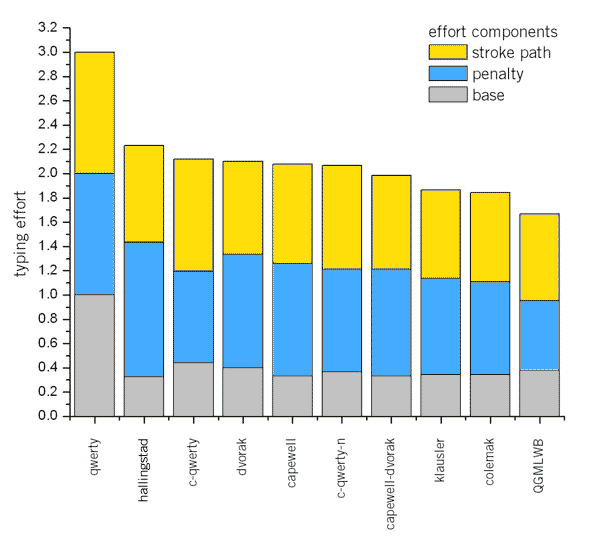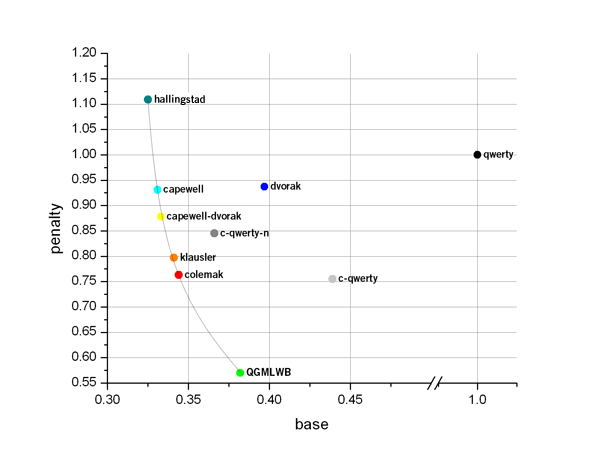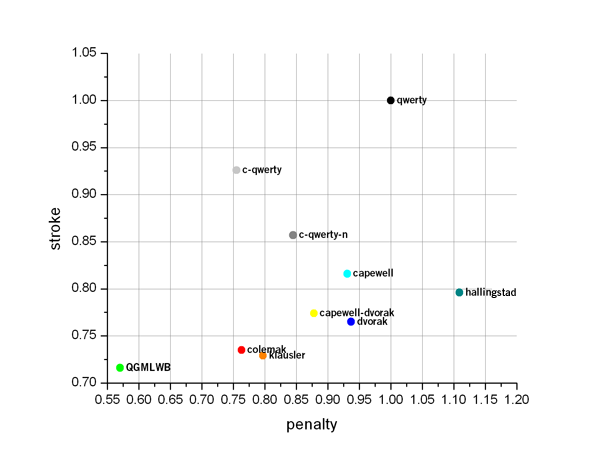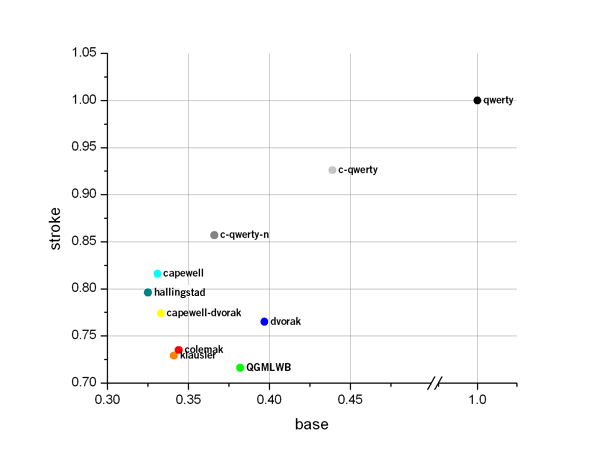Have ideas? Tell me.
the best layout
Partially optimized QWKRFY and fully optimized QGMLWY layouts are the last word in easier typing.
the worst layout
A fully anti-optimized TNWMLC layout is a joke and a nightmare. It's also the only keyboard layout that has its own fashion line.
download and explore
Download keyboard layouts, or run the code yourself to explore new layouts. Carpalx is licensed under CC BY-NC-SA 4.0.
layouts
Download and install the layouts.
Popular Alternatives
ON THIS PAGE
Plots of Typing Efforts of Popular Alternatives
Table of Typing Efforts of Popular Alternatives
A detailed graphical comparison of typing efforts of a variety of keyboard layouts. The efforts shown here should be compared to the layouts' detailed finger and row usage statististics.
Plots of Typing Efforts of Popular Alternatives
The following plots should give you a feeling of how the layouts compare in terms of their total effort and effort components. Recall that the effort is divided into the following components: base (finger distance), penalty (row- and finger-based penalties) and stroke path (progression of hand/finger use).

From Figure 1 a few generalities emerge. First, QWERTY has a much higher effort than all other layouts, with the next best layout (Hallingstad's Arensito layout) having a 25% lower effort. Second, the spread in total effort among the layout alternatives is the same (25%, 1.668-2.230) as the difference between QWERTY and Hallinstad. This means that QGMLWB improves on Hallinstad's layout as much as Hallingstad's layout improves on QWERTY.
Second, the proportion of effort components among the various layouts is quite different. The plot above shows that Hallingstad's layout has the lowest base effort (0.325), but a very high penalty. These differences are expounded in the individual plots below, which focus on a pair of effort components at a time.

The story that Figure 2 figure tells is interesting. The lowest base effort is found in the layout with the highest penalty: Hallingstad's. This layout is designed entirely around a low base effort; that is, finger travel distance is the lowest in this layout of all the alternatives presented here. Six of the layout data points fall on a simple curve, which is not expected, but likely by chance. However, it is clear that there is an negative correlation between base and penalty components: a lower base component comes at a cost of higher penalty.
This plot also suggests that the base effort component is one in which the greatest improvement can be made over QWERTY.

When penalty and stroke path components are drawn, as in Figure 3, we can see that QGMLWB is the best performer, with Colemak and Klausler neighbouring with similar stroke values but significantly higher penalty values. The plot also suggests that penalty and stroke components are correlated — optimizing one results in the other component also lowered.

The final component pair-wise comparison is the base and stroke components shown in Figure 4. Here the correlation is sharply negative, with base component improvement resulting in an increased stroke path. Given that both penalty and stroke components are negatively correlated with the base component, there is a limited benefit in forcibly decreasing the base component.
The stroke-vs-base profile of the six layouts joined by the curve in the penalty-vs-base profile in Figure 2 is very similar. As base effort is decreased, the layouts are ordered by their stroke effort nearly in the same progression as by their penalty efforts.
Table of Typing Efforts of Popular Alternatives
The efforts shown here are sorted in decreasing order. QWERTY, not surprising, has the highest effort, followed by the Hallingstad layout (aka Arensito), c-QWERTY and others. The last layout in the list is the fully optimized QGMLWB layout (it isn't a popular alternative ... yet).
Notice that c-qwerty and QGMLWB are the only two layouts that improve on QWERTY in every category (including the row- and finger-based penalty components). All other layouts have a higher finger-based penalty - this is due to their increased use of the pinky. Colemak has the smallest increase of finger-based penalty over QWERTY.
| Efforts of Popular Alternative Layouts | |||||
|---|---|---|---|---|---|
| model | keyboard | total effortrel% | effort contributionsrel% | ||
| base | penalties | path | |||
| mod_01 | qwerty |
3.000
|
1.00033.3
|
1.00033.3
R0.408 F0.408 |
1.00033.3
|
| hallingstad |
2.230
(-25.7)
|
0.32514.6
(-67.5)
|
1.10949.7
(+10.9)
R0.232 (-43.1) F0.680 (+66.7) |
0.79635.7
(-20.4)
|
|
| c-qwerty |
2.119
(-29.4)
|
0.43920.7
(-56.1)
|
0.75535.6
(-24.5)
R0.242 (-40.7) F0.381 (-6.6) |
0.92643.7
(-7.4)
|
|
| dvorak |
2.098
(-30.1)
|
0.39718.9
(-60.3)
|
0.93744.7
(-6.3)
R0.171 (-58.1) F0.638 (+56.4) |
0.76536.5
(-23.5)
|
|
| capewell |
2.078
(-30.7)
|
0.33115.9
(-66.9)
|
0.93144.8
(-6.9)
R0.225 (-44.9) F0.544 (+33.3) |
0.81639.3
(-18.4)
|
|
| c-qwerty-n |
2.068
(-31.1)
|
0.36617.7
(-63.4)
|
0.84540.9
(-15.5)
R0.182 (-55.4) F0.524 (+28.4) |
0.85741.4
(-14.3)
|
|
| capewell-dvorak |
1.985
(-33.8)
|
0.33316.8
(-66.7)
|
0.87844.2
(-12.2)
R0.199 (-51.2) F0.549 (+34.6) |
0.77439.0
(-22.6)
|
|
| asset |
1.894
(-36.9)
|
0.35618.8
(-64.4)
|
0.76640.4
(-23.4)
R0.158 (-61.3) F0.504 (+23.5) |
0.77240.8
(-22.8)
|
|
| klausler |
1.867
(-37.8)
|
0.34118.3
(-65.9)
|
0.79742.7
(-20.3)
R0.141 (-65.4) F0.563 (+38.0) |
0.72939.0
(-27.1)
|
|
| colemak |
1.842
(-38.6)
|
0.34418.7
(-65.6)
|
0.76341.4
(-23.7)
R0.158 (-61.3) F0.487 (+19.4) |
0.73539.9
(-26.5)
|
|
| workman |
1.993
(-33.6)
|
0.33616.9
(-66.4)
|
0.84842.5
(-15.2)
R0.200 (-51.0) F0.505 (+23.8) |
0.80940.6
(-19.1)
|
|
| norman |
1.992
(-33.6)
|
0.34217.2
(-65.8)
|
0.81240.8
(-18.8)
R0.191 (-53.2) F0.508 (+24.5) |
0.83842.1
(-16.2)
|
|
| abkey |
2.109
(-29.7)
|
0.34416.3
(-65.6)
|
0.88542.0
(-11.5)
R0.234 (-42.6) F0.488 (+19.6) |
0.88041.7
(-12.0)
|
|
| qgmlwb |
1.668
(-44.4)
|
0.38222.9
(-61.8)
|
0.57034.2
(-43.0)
R0.153 (-62.5) F0.363 (-11.0) |
0.71642.9
(-28.4)
|
|
